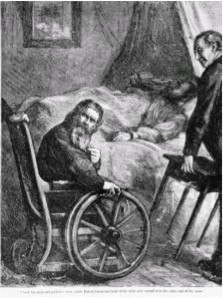by Jolene Zigarovich

The currently unprecedented visibility of trans characters, issues, and lives seems to be part of a larger political conversation and movement, especially in the United States. While issues such as bathroom bans, workplace discrimination against the trans-identified, housing discrimination, lack of access to health care and social services, and other legal and political debates abound, the intersex and transgender community has received sustained national, and now global, attention. As Stephen Whittle puts it, “a trans identity is now accessible almost anywhere.” Third-gender (or gender variant option) categories are emerging on government documents and applications in Europe, the Middle East, and Southeast Asia. The familiar woman/man binary in global bureaucratic and administrative structures is seeing a distinct shift and reassessment. However much transgender, like other contemporary categories of identity, “operates within neoliberal conditions,” Susan Stryker and Aren Aizura recognize that it has also offered powerful critiques of both homo- and hetero- nationalisms and normativities, as well as critiques of gender regulation itself as a tool of biopolitical governmentality.” With this political context, formulating an approach with which to interpret literature and culture with the trans prefix has added cultural weight and understanding to utilize and deploy. Thus my essay, and this special issue of “Trans Victorians” curated by Ardel Haefle-Thomas, seeks to illuminate the productive ways transgothic bodies, identities, and rhetorics contribute to a wide variety of critical and necessary interpretations.
In taking up the gender nonbinary and transgender characters in The Law and the Lady I’m not suggesting Collins was directly aware of his culture’s medical and scientific approaches to what we would now term the transgender and intersex populations, but his novel seeks to subvert gender norms through nonbinary characters. In part, my essay shows that the sensation genre allows for and celebrates these subversions and creates spaces for sympathizing with non-normative characters. As the essay examines proto-trans characters and transgender potentialities in The Law and the Lady, we can better understand Collins’s overt and covert rejection of rigid gender binaries, noting that sensation fiction often portrayed a society in which secure gender identity was being questioned. Specifically, I’m claiming that these trans possibilities are dramatically developed in this text as the medical investigation of genderqueer and transgender people was growing in social interest. The Law and the Lady exploits and fetishizes trans characters, and in several instances institutionalizes or punishes them for their difference. For example, Dexter and Ariel are mutually coupled in their disabilities, gender variance, and sadomasochistic tendencies. Caregiver and devoted servant and partner, Ariel cannot exist without her mutually “strange” counterpart, and both she and Dexter are ultimately victimized by and sacrificed to the prevailing heteronormative social structure. Yes, their violent love is erotic and interdependent; yet Dexter and Ariel have created a private world where their nonconforming gender identities are accepted and mutually supported. Acknowledging the benefit of disability studies and crip readings of the novel, my approach seeks to illuminate the novel’s transgender characterization, showing how Collins’s non-normative characters are (if only temporarily) provided trans spaces, lives, and families.
For more, see Jolene Zigarovich, “A Strange and Startling Creature” Transgender Possibilities in Wilkie Collins’s The Law and the Lady.” Victorian Review, vol 44, no 1, 2018, pp. 99-111.J
